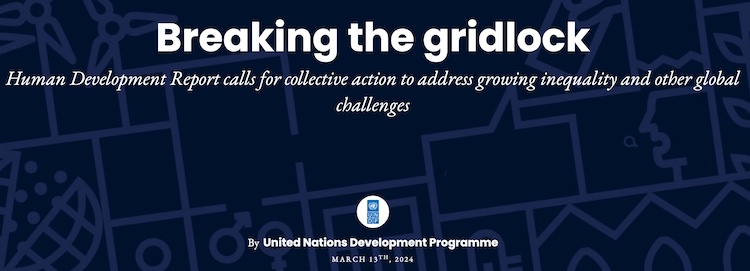By José Antonio Ocampo and Karla Daniela González, Columbia University
This article was first published in the 2023/2024 UNDP Human Development Report – Breaking the Gridlock: Reimagining cooperation in a polarized world –on 13 March 2024.
NEW YORK | 14 March 2024 (IDN) — There is broad-based agreement among the United Nations and the Group of 20 (G20) and in the proposed Evolution Roadmap of the World Bank that multilateral development banks should provide financing to support developing countries’ contribution to global public goods.
Multilateral development banks have increased their financing for climate change mitigation and adaptation and to a lesser extent for combating pandemics and supporting biodiversity. However, the resources provided are still very small relative to what is needed. To enhance such financing, the institutions mentioned above share three recommendations.
- Increase financing to support the provision of global public goods by developing countries.
- Include contingency clauses to respond to the vulnerability of countries associated with climatological and health issues and to manage the effects of international economic crises on these countries. These clauses should allow the suspension of debt service with these institutions and even, eventually, a reduction in associated liabilities.
- Work more closely with the private sector to support its contribution to global public goods.
The need to channel concessional credits or donations
An essential theme of all these proposals is the need to channel concessional credits or donations through multilateral development banks. Furthermore, these benefits must also favour middle-income countries and create mechanisms that allow partial subsidies for credits to the private sector to leverage their investment in providing public goods. To make this possible, official development assistance must be greatly increased, an important challenge given the limited funds now available.
Aside from concessional resources, the proposals call for longer-term multilateral development bank loans (30–50 years), with longer grace periods and lower interest rates. To manage exchange rate volatility, multilateral development banks must lend more in the national currencies of borrowing countries, based on the resources they raise, with the placement of bonds in these currencies, which would also support the development of national capital markets.
Various other financial management proposals would enhance the relationship between the financing of multilateral development banks and their capital, while maintaining the standards that allow these institutions to maintain high investment grades in bond markets. Innovative financial mechanisms are needed to leverage private investment, including guarantees and public–private partnerships.
Developing a new instrument
To expand available resources, the Special Drawing Rights (SDRs) issued by the International Monetary Fund (IMF) that have not been used by developed countries could be channelled through multilateral development banks, which are already authorized to hold such assets. This will require developing a new instrument that preserves the role of SDRs as reserve assets, based on the experiences of IMF funds that have already developed such mechanisms.
One of those funds is the Resilience and Sustainability Trust, which operates as a loan-based trust.
Approximately three- quarters of IMF member countries—all low-income countries, developing and vulnerable small states and lower-middle-income countries—are eligible for extended affordable financing from the trust.1 It is strategically oriented to address prolonged structural challenges, notably those related to climate change and pandemic preparedness. Since becoming operational in October 2022, it has approved 11 arrangements through its Resilience and Sustainability Facility.
For multilateral development banks to fulfil all these functions, as well as their traditional ones, the most important element is their capitalization. Capitalizations of the World Bank in 2018 and of all multilateral development banks after the 2007–2008 global financial crisis responded to this demand. A source of uncertainty, however, is whether some major shareholders are willing to capitalize the World Bank and regional banks again.
The proposals differ considerably in the magnitude of the capitalizations required. The independent experts organized by the G20 proposed increasing the annual financing of these institutions to $500 billion by 2030, a third of which would be in official development assistance or concessional credits and the rest in non-concessional credits. Given the amount of bank approvals by multilateral development banks to developing countries, this means approximately tripling the value of their loans.
Much more ambitious
UN estimates of the stimulus needed to achieve the Sustainable Development Goals (SDGs) are much more ambitious. In February 2023 the UN Secretary-General highlighted how the relationship between multilateral development bank financing and the size of the world economy was substantially reduced in the 1960s and 1970s, particularly for the International Bank for Reconstruction and Development of the World Bank Group.
For this reason, the United Nations has suggested that a return to 1960 levels would imply a threefold increase in capitalization, enabling an increase in loans of nearly $2 trillion, an amount closer to the SDG financing gap.
Finally, it is important that multilateral development banks constitute a service network. In the case of the World Bank, this includes participating in regional projects alongside regional partners. Added to this is the need for all multilateral development banks to work with national development banks and other public institutions. Public development banks finance 10–12 percent of investment worldwide, although with considerable differences across countries. This collaboration would allow national banks to become executors of global public goods programmes, as well as channels of information on the related financing needs of their countries. [IDN-InDepthNews]
Image credit: UNDP












